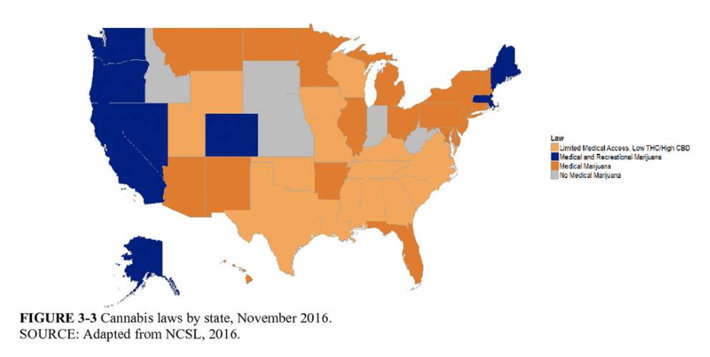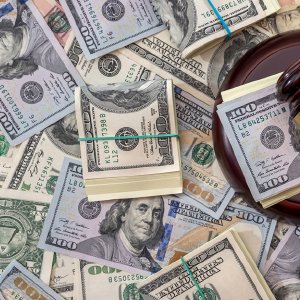The Normalization of Marijuana Use in America
Depending on the news media you follow, you might have seen signs that marijuana use is successfully being “normalized” in the minds of Americans. The map below is one of those signs. It shows the extent of legalization of cannabis in the U.S.

There are three levels of legalization:
1. Limited access to medical cannabis, which means products with high CBD and low THC are available for a few medical conditions only. (light orange)
2. Medical marijuana is legal with a doctor’s recommendation. (dark orange)
3. Recreational marijuana may be sold to those over 21. (blue)
Only the gray states (Idaho, South Dakota, Kansas, Nebraska, Indiana and West Virginia) do not permit any sales of marijuana.
A Comment About CBD
In case you are not familiar with the different components of cannabis, CBD refers to cannabidiol, a component that does not make people high but offers therapeutic benefits. THC is tetrahydrocannabinol, the component people want when they wish to get high.
Make no mistake, the products flying off the shelves in both medical dispensaries and recreational/retail marijuana stores is the high-THC product. A small proportion of the cannabis-buying public focuses on high-CBD products because they have a medical condition that responds to CBD. For example, some children with seizures that can’t be halted with any known medication sometimes find relief with CBD. Others do not.
Do Americans Really Want Legalization?
It’s easy to find surveys that show that Americans are willing to have marijuana legalized in their states. But how did they come by this opinion? It turns out that many tens of millions of dollars have been spent to shape these opinions. For example, in Maine in 2016, $1.3 million dollars was spent on supporting the pro-marijuana referendum. This figure was 26 times the budget spent to oppose legalization.
Before the 2016 vote on the medical marijuana amendment in Florida, opponents to legalizing smoked medical marijuana were outspent 2 to 1. The amendment passed. Previously, non-smoked, high CBD products had been available to treat a very limited number of health conditions.
Why are supporters willing to spend so much money to help pass these laws and amendments? And why would a Tampa attorney spend $2.6 million of his own and his firm’s money to support legalization? Because there are billions of dollars to be made when sales of this addictive product are made legal.
The outcome of all this money is that Americans are becoming more accepting of the “normalization” of marijuana use. Unfortunately, this attitude has a much greater effect than just swaying people’s votes. It infiltrates the home and our school systems. One Spokane, Washington school administrator said that legalized recreational marijuana had normalized the idea of marijuana use among both parents and students. Very young students would come to school smelling like their parents’ pot smoke and older students might be found in possession of their parents’ pot supplies in school. She told the story of one mother who came to the school to get her supply back after it had been confiscated by the school.
America Needs Sobriety to Stay Strong
This is how the National Institute on Drug Abuse describes the effects of marijuana:
Immediate: Distorted perception, difficulty with thinking and problem solving, and loss of motor coordination.
Long-term: Use of the drug can contribute to respiratory infection, impaired memory, and exposure to cancer-causing compounds. Among youth, marijuana use has been linked to increased risk for developing mental difficulties and poorer cognitive functioning.
In 2014, Governor Jerry Brown of California voiced his concerns about the growing legalization of marijuana. “How many people can get stoned and still have a great state or a great nation?” he told reporters. “The world’s pretty dangerous, very competitive. I think we need to stay alert.”
The normalization of this drug opens the door to use by any of our more vulnerable population. As with any other substance, relying on an addictive substance instead of successfully coping with life is a very damaging practice. One out of eleven people of any age who start using marijuana will become addicted to it. When the person starting to use the drug is in their teens, the risk is even higher.
At this point, there’s no going back. American is legalizing marijuana in one state after another. This is bad news for the vulnerable among us. Some people starting with marijuana will migrate to more deadly drugs and some will simply continue to impair their abilities with marijuana.
When use becomes addiction, no matter what substance is being used, there needs to be a reliable path back to sobriety. For tens of thousands of people over the last fifty years, that path has been the Narconon drug rehab program.
The rehab program at Narconon Ojai uses no drugs as part of its program—instead, each person learns how to develop the life skills and abilities that enable them to cope with life successfully, without drugs of any kind. Recovery from addiction does not take place overnight—for most people, it takes eight to ten weeks to develop the confidence that they can live drug-free.
When you need to help someone you care about find a new “normal” of health, brightness and ability, call Narconon Ojai for help.


